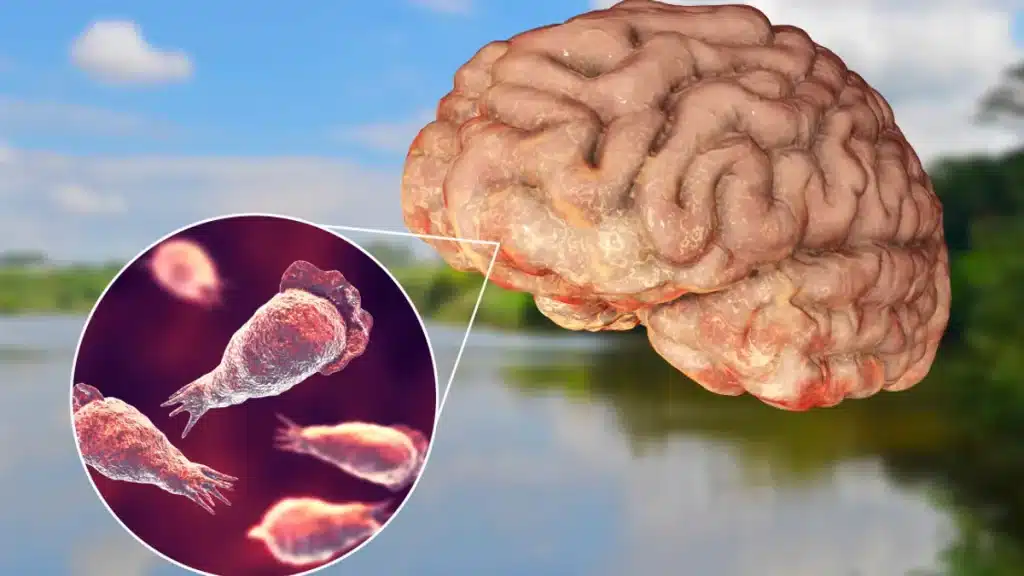In a heart-wrenching twist of fate, a cherubic toddler, the very embodiment of his parents’ pride and joy, met a tragic end, falling victim to the clutches of a brain-eating amoeba that lurked beneath the innocuous veneer of an Arkansas country club’s splash pad.
The young angelic soul, known as Michael Alexander Pollock III, at a tender age of merely 16 months, departed this realm on the mournful day of September 4th. This cruel twist of fate unfolded while his devoted parents, Michael Jr. and Julia Pollock, were away on distant shores, as recounted by the esteemed Arkansas Online.
In a stark confirmation delivered via a press release, the Arkansas Department of Health unveiled the grievous news of the toddler’s demise, attributing it to a lethal infection orchestrated by none other than the insidious amoeba, Naegleria fowleri, infamous for its brain-invading tendencies. The tragic tale takes an even more harrowing twist as officials surmise that the young tyke’s rendezvous with this brain-devouring menace transpired amid innocent merriment at a splash pad nestled within the bosom of a tranquil Little Rock, Arkansas, country club.
This heart-wrenching narrative finds its poignant climax in the obituary of the tender child, penned by his grieving parents. There, they pour out their souls, acknowledging how their precious Michael, born on April 24, 2022, illuminated not only their lives but also those of countless others with his infectious smile and boundless playfulness.
“Michael, born April 24, 2022, was the pride and joy of his parents, Michael Pollock Jr., and Julia Pollock, who survive him,” the obituary lovingly proclaimed. “Though Michael’s time on Earth was short, he touched the hearts of family, friends, and even strangers he came across with his illuminating smile and playfulness.”
In the backdrop of this heart-rending tale, the CDC’s ominous warning adds a chilling layer of intrigue. Naegleria fowleri, it seems, thrives in the embrace of warm waters, a fiend that flourishes most fervently at temperatures soaring as high as a scorching 115°F. Herein lies the crux of the matter – July, August, and September, those sweltering summer months, emerge as the pinnacle of vulnerability.
Yet, there’s a disconcerting thought that lingers in the air; a specter known as climate change looms ominously. Some experts ponder whether this global shift may, in fact, sow the seeds of more frequent encounters with Naegleria fowleri. As they put it, “As air temperatures rise, water temperatures in lakes and ponds also rise and water levels may be lower,” a sinister alignment of factors that could spell doom. “These conditions provide a more favorable environment for the amoeba to grow.” It continues, ominously, “Heat waves, when air and water temperatures may be higher than usual, may also allow the amebae to thrive.”
The tale of this vicious amoeba unfolds with a sinister flair. Its malevolent grasp doesn’t take long to manifest, typically seizing its hapless victims about five days after their unwitting exposure. Early symptoms, treacherous harbingers, often include that persistent drumming in the head, the relentless nausea, and the fiery chills of fever, occasionally punctuated by the unsettling dance of vomiting, according to the CDC.
But the story doesn’t end there; no, it takes a far darker turn as the infection tightens its grip. Confusion weaves its insidious web, a stiff neck whispers of impending doom, disorientation plunges the mind into chaos, and hallucinations dance at the periphery of consciousness. The climax of this macabre drama may culminate in the grotesque spectacle of seizures and, ultimately, the abyss of coma.
And then, in a macabre twist that defies all reason and compassion, death slithers into the equation. It can strike anywhere from a mere one day to a harrowing 18, with an average of five days, as per the CDC, shrouding this tale in a shroud of merciless unpredictability.
As we part from this narrative, we are left not only with the haunting memory of a toddler who was the embodiment of his parents’ love but also with the unsettling awareness of the lurking horrors that can surface in the most unassuming places, in the heart of a summer’s splash.






